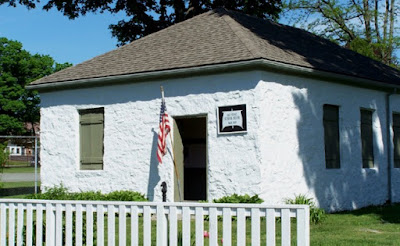Old-School Microdistricts
In 2010-2011, I was writing quite a lot in on this blog about the advantages that would accrue from regionalizing some services in Massachusetts -- consolidating the work of towns that is done by counties in most of the United States.
It would simplify communication between state agencies and local workers, and increase the proportion of funding that would go directly to services. As logical as some county-level service provision would be, it is not going to happen in my lifetime, because of the "illusion of local control," as Gov. Patrick and I described it in a 2009 discussion. We used the word "illusion" because the small scale of governance allows taxpayers to make detailed decisions -- like a town-meeting vote on whether to buy new tires for a police car (I exaggerate only slightly) -- while unfavorable economies of scale very much constrain those decisions. Overhead is quite high, with thousands of people employed managing things who could be much more usefully employed doing the things. Search the word "regionalization" on this blog to see some specific example or read my case for regionalization page for a detailed explanation.
 |
| Old Stone Schoolhouse. Image: Fairhaven Office of Tourism |
This all came to mind yesterday as my favorite librarian and I visited this Old Stone Schoolhouse in the Oxford Village area of Fairhaven. Our main goal was to learn more about the history and geography of the seaside town that began being our part-time home about two years. The outing was certainly successful -- in less than an hour we learned a great deal from the "schoolmaster" docent who connected this 1828 structure to many Fairhaven events, personalities and structures. He also helped us to understand the daily life of teachers and students in nineteenth-century New England towns.
It was the story of the school's construction, though, that gave us new insight into the current resistance to regionalization. When Fairhaven was incorporated in 1812, it included what is now the town of Acushnet, immediately to the north. The two towns cover just under 35 square miles and today have a combined population of less than 25,000 people. The Commonwealth of Massachusetts required that school districts be formed within towns, with each district required to provide for the education of children in that district.
Here is the amazing bit: within this small town, NINETEEN districts were created. This made some sense, in an age when every child would walk to school. But by the end of the century, reform movements would consolidate districts at the town level to reduce variations in funding and in the quality of instruction.
So the town-level administration we find today — with 250 school districts where 20 would do, but where a couple thousand had been — is regionalization enough by nineteenth-century standards. And as anybody who has been in New England very long knows, nineteenth-century standards are, well, standard in many aspects of life.
Lagniappe: Climate Change
Among the many interesting stories we heard during our brief visit to the Old Stone Schoolhouse was one about the commute of a teacher who lived in the center of town, about a mile and a half south of the school to which she was assigned. This was unusual enough that stories were handed down of her walking to school along Main Street in the warmer months -- and ice skating along the Acushnet River in the winter. I have been rowing year-round in the Acushnet River for the past five years, and although I have encountered some ice along the margins and even slabs of ice in the open water, I have never encountered ice that one would even consider skating on.


Comments
Post a Comment